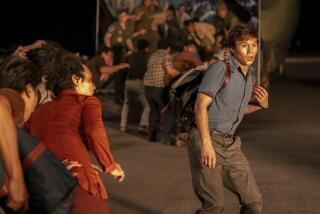Reflections of âCommonâ GIs on Vietnam
CHANHASSEN, Minn. â The remarkable thing about Jerry Osgoodâs extraordinary little magazine is its very ordinary view of the Vietnam War.
âIâm looking at the typical guy doing his 365 days loading a forklift in mud and rain in 110-degree heat,â says Osgood, who spent his 365 days in warm mud and hot rain with the 4th Cavalry, 25th Infantry Division, at Tay Ninh. âIâm looking at the ordinary GI who waded through a swamp at dusk to set up for a night ambush. Iâm looking at your normal helicopter pilot going into openings too small for a chopper unless you were crazy. . . .â
He should also be looking at quick and absolute failure for his curious quarterly. Spelling errors outnumbered the staff for the first issue because its $250 editorial budget didnât stretch to a proofreader. The prototype was pasted up on a living-room floor using type faces and dummy photographs clipped from old covers of Gun Digest and Ladiesâ Home Journal. Osgood probably is the only editor-publisher in America who doesnât type.
And the photograph illustrating his obligatory Letter From the Editor was clipped from a snapshot taken by his 12-year-old son who used a box camera bought at a garage sale and a screwdriver to advance the film.
Yet . . . last monthâs first, hesitant issue of Reflections sold all 20,000 copies in four days. Thereâs sufficient demand for a second run of 100,000 at $2.95 each. B. Dalton Bookseller has agreed to distribute the second issue through 750 stores from the South Bronx to Southern California. Annual subscriptions are building. Daily mail is by the bag and totally supportive. News coverage of this little magazine from Lake Wobegon country has broadened from the St. Paul Pioneer Press and Dispatch to nibbles from network television.
That tells Jerry Osgood just one thing: âI was right.â
He was right, he says, about a longing for a bulletin board where Vietnam veterans can pin their memories. A yearbook for all the classes of â62 through â72. A newsletter. Definitely not another grim stone memorial to 58,000 Americans who died, but a digest and exchange and forum for the 3,250,000 men and women who served and lived.
The politics and human loss of this war, Osgood believes, have been told and retold almost ad infinitum. Drugs and sex and rock ânâ roll. Social rejection. Post Traumatic Stress Disorder. My Lai. Agent Orange. âBut these are extremes that probably didnât touch more than 20% of those who served in Vietnam,â he said. âThat leaves at least 80% of the guys who really did the dirty work, the typical people you never hear about, the Doughnut Dollies, just girls, just typical, round-eyed American girls who came out and talked to us.
âTo this day I donât know where they were from. Maybe the Red Cross, I donât know . . . but thatâs the type of human interest information I want to get out.â
Sidestep Rhetoric
He says the magazine cannot avoid the major facets of the Vietnam hangover and the POW-MIA issue is one. Yet it will try to sidestep rhetoric in favor of current, factual developments. Reflections will not deny the negatives of war. But it must also recognize the exhilaration, brotherhood, growth and honest patriotism of its warriors.
In short, Osgood explained, the publication will pivot on memories that tell a story, that create conclusions, that form an education to be shared . . . in total, he said. The Vietnam Experience as it touched both GI and civilian.
âReflections will be their medium, a magazine where the reader is the writer,â said Osgood, 36, now an electronics technician with a specialty in robotics. âWhatever they want to say is fine and I donât care if it comes from Jane Fonda or some gung-ho Green Beret loaded with medals.
âAs we say in the front of the magazine where weâre describing its purpose: âReflections is not looking for great stories. Reflections is looking for great moments. Great moments that will tell a great story.â â
Graphics Fell Short
The first cover of Reflections, however, fell somewhat short of greatness in graphics. Wrote a reporter for the Chicago Sun-Times: âA boring photo of an old guy holding a picture of his son.â Some contents of the maiden issue, as Osgood acknowledged, were a mite stale and in slight contradiction to his concept: An outline of federal benefits stemming from Agent Orange litigation and a psychologistâs pointers on handling PTSD.
Yet there also was a poem by Marcie Stoyke that tells of the conflict between private despair and the public purpose a wife must show for her soldierâs cause:
I am a Vietnam wife;
I have survived the nightmare
screams.
War horrors occupy his head
At night they lay between us
Asking for him
Laughing at me
And I know
He is dying.
Diane Carlson Evans, a former Army nurse at Pleiku, wrote for the 10,000 women who served in Vietnam and outlined a current campaign to have a statue of an Army nurse raised alongside the Vietnam Veterans Memorial. . . .
An unidentified soldier recalled flying home in 1969 and how at Travis Air Force Base near San Francisco 250 men could not leave the airplane because too many friends would never come home . . . .
There were statements from veteransâ wives, forensic civilian anthropologists and pathologists who claim that bone fragments identified by the military as those of named American servicemen cannot possibly be identified as the human remains of any individual . . . .
Another poem. Another reflection. By Nancy Harrison:
Long, black granite slab
slices through the green lawn
memorializing the war
that sliced through the country.
Its face--chiseled with names--
honoring the fallen dead
matching scars in the minds of
the anguished living.
Vietnam lives,
In Dream,
and screams,
and mental wards,
And roses on the graves.
Barb Colby of Minneapolis wrote of a school friend, Bob, who died in Vietnam and her lengthy concern because they never shared goodbys: âI have always had a sense of incompleteness,â wrote Colby. âWhether you print this or not, thanks for the chance to share my feelings.â
Thanks. They came to Osgood by telephone call, postcard and letter. They came from a Gold Star Mother who was afraid that too many have forgotten about Gold Star Mothers. Then she started weeping.
âIâve had vets who said they had to go off and read it alone because it was them,â Osgood said. âIt was something they clearly related to . . . yet the first issue of the magazine was nothing but a gut feeling. I published what I felt America wanted to know.â
Itâs all very uncomplicated. Cathartic, certainly. Simplistic, maybe. Yet ordinary, say some. As in natural. As in Jerry Osgood.
He was born in St. Cloud, Minn., population 42,566, principal products: granite, lenses, freight cars. Son of a sheet-metal worker who served in the Navy during World War II, Osgood attended Cathedral High School where he was good at art and terrible at basketball. He enlisted in the Army at 18 because there was a war on and he and buddy Ralph Spoden had nothing else to do that winter of 1968.
âFor Patriotic Reasonsâ
âAbout 50% of my class went into the service and I would say the majority enlisted for patriotic reasons. We felt good about that and we felt good about ourselves. So it (enlistment) was just something you did.â
Osgood was neither a searcher nor a destroyer. He was a maintenance man. But that meant work from a 45-man post near Tay Ninh and going where the Armored Personnel Carriers and convoys went. He was there when men took rockets in their chests and when there were half-cremated soldiers to be recovered from the cooling armored personnel carriers. Osgood earned his jungle rot. From hairline to collarbone.
âBut it wasnât totally negative. You became brothers with the other guys because we were all together, no matter your nationality, color or religion. Maybe you got even closer in a few weeks than you got with your own brother in years. . . .â
He came home and didnât quite fit. There were some bad dreams and an opposition to authority. Heâd often sit alone in a closed room and be irritated by the realities of St. Cloud. They just didnât seem real.
Osgood knew he wasnât unusual. No different from Ralph Spoden, who also made it back. They were just two GIs in 3 million.
So he wrote a 250-page manuscript and called it âSome Motherâs Son.â It told of a Christmas at war and cold turkey-loaf C-rations. It told of body counts that worked like frequent-flier programs: The higher the count the bigger the bonus pass to Saigon.
More Blood and Guts
But publishers werenât interested in the book. Not unless they could rewrite it. More blood and guts, they said. Hold the mush. No thanks, Osgood said. That wouldnât be the way it was. âYou didnât go over there to become an animal,â he said. âYou went over there and survived.â
Maybe, he discussed with friends, there was material here for a newsletter. Or maybe, they decided, it could be made into a magazine for all the ordinary guys.
Denise Starnes, a friend from the electronics business, said if editing meant a skill for reading stories she certainly was qualified to be an assistant editor--also, she believed in Osgoodâs perspective of the war. Terry Yurek who publishes Thoroughbred Express, a guide to Canterbury Downs, volunteered to be distribution and advertising manager--because he hadnât served in Vietnam and there was a time when he felt very guilty about that.
An artist, a Vietnam veteran, came on board. A local printer said he knew a good publication when he saw one and Reflections certainly qualified for his 90-day delayed payment program. Professionals were borrowed for the price of an acknowledgement and thatâs how the words of Myra MacPherson, author of âLong Time Passing,â and Carol Byrne, a staff writer for the Minneapolis Star and Tribune, appeared in the first issue.
And although some stories werenât logged in the index and one writer introduced a new military weapon called a â45-caliper pistolâ and the editorial titles were just a little overpowering . . . well, no matter the flaws, it has been impossible to argue with a four-day sellout.
It has cost Osgood. Some early newspaper stories say he hasnât had a good nightâs sleep for months because heâs always coming up with a new idea for the magazine. Thatâs not quite true. Sleeplessness, Osgood said , comes from reading others telling of what he has felt and that stirs up old dross and the jagged nights have returned.
Harold John Smithâs Story
Reflections also has brought him in touch with a man he never knew. Osgood said that Harold John Smith may be the very symbol of his magazine.
Smith died in Vietnam in 1969. He was just 21. He was just a farm boy. He was just another American youth and son and brother. He was just one among 1,060 Minnesota men killed in the war. And that, in a peculiar way, makes Harold Smith more unknown, certainly less visited, than any unknown soldier.
The story of Harold Smith, from boyhood in Stillwater to sacrifice near Cu Chi, from his death in 1969 to his changed and diminished family today, from motivation then to the meaning of it now, appeared in the first issue of Reflections.
It took Osgood to the Smith farm. He stood in the rumpus room where Harold had studied and watched TV and roughhoused. He heard the bitterness of a father who looks at his sonâs medals, Army portrait and presidential letter of sympathy and sees absolutely no glory in them: âImpressive? I suppose so,â Glenn Smith said. âBut not much in trade for a 21-year-old boy, are they?â
Last month, for the first time, Osgood visited Smithâs grave and white military tablet among the sad rows at Fort Snelling National Cemetery. He had delayed the moment until he was sure he could handle it. Osgood thinks he must have known Smith. They were both with the 4th Cavalry, 25th Infantry Division, in 1969 and in the Tay Ninh-Cu Chi area. Osgood repaired armored personnel carriers. Smith commanded one. Smith could even have been one of the six bodies Osgood once found in a broken carrier.
âIâm sure we crossed paths,â Osgood said. âIâve looked at his photograph and the face looks awfully familiar. But you never knew who everybody was. There were so many guys coming in and going out.
âWe were just there to do a job. You got there, you accepted it, you did your 365 days and went home. That was the best way to handle it. Thatâs what the majority did and thatâs what it was really like. . . .â
More to Read
Sign up for our Book Club newsletter
Get the latest news, events and more from the Los Angeles Times Book Club, and help us get L.A. reading and talking.
You may occasionally receive promotional content from the Los Angeles Times.








